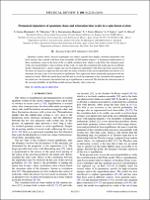Please use this identifier to cite or link to this item:
https://hdl.handle.net/20.500.12202/6447Full metadata record
| DC Field | Value | Language |
|---|---|---|
| dc.contributor.author | Santos, Lea F. | - |
| dc.contributor.author | Bastarrachea-Magnani, M. A. | - |
| dc.contributor.author | Lerma-Hernández, S. | - |
| dc.contributor.author | Torres-Herrera, E.J. | - |
| dc.contributor.author | Hirsch, J.G. | - |
| dc.contributor.author | Villaseñor, D. | - |
| dc.date.accessioned | 2020-11-19T19:31:28Z | - |
| dc.date.available | 2020-11-19T19:31:28Z | - |
| dc.date.issued | 2019-07-31 | - |
| dc.identifier.citation | Santos, Lea F., S. Lerma-Hernández, D. Villaseñor, M. A. Bastarrachea-Magnani, E. J. Torres-Herrera, and J. G. Hirsch. (2019). Dynamical signatures of quantum chaos and relaxation time scales in a spin-boson system. Physical Review E 100(1): 012218, | en_US |
| dc.identifier.issn | Print: 1539-3755 Electronic: 1550-2376 | - |
| dc.identifier.uri | https://doi.org/10.1103/PhysRevE.100.012218 | en_US |
| dc.identifier.uri | https://hdl.handle.net/20.500.12202/6447 | - |
| dc.description | Research article, peer-reviewed. Open access. | en_US |
| dc.description.abstract | Quantum systems whose classical counterparts are chaotic typically have highly correlated eigenvalues and level statistics that coincide with those from ensembles of full random matrices. A dynamical manifestation of these correlations comes in the form of the so-called correlation hole, which is a dip below the saturation point of the survival probability's time evolution. In this work, we study the correlation hole in the spin-boson (Dicke) model, which presents a chaotic regime and can be realized in experiments with ultracold atoms and ion traps. We derive an analytical expression that describes the entire evolution of the survival probability and allows us to determine the time scales of its relaxation to equilibrium. This expression shows remarkable agreement with our numerical results. While the initial decay and the time to reach the minimum of the correlation hole depend on the initial state, the dynamics beyond the hole up to equilibration is universal. We find that the relaxation time of the survival probability for the Dicke model increases linearly with system size. | en_US |
| dc.description.sponsorship | We acknowledge the support of the Computation Center-ICN, in particular to Enrique Palacios, Luciano Díaz, and Eduardo Murrieta. D.V., J.G.H., M.A.B.-M., and S.L.-H. ac-knowledge Jorge Chávez-Carlos for fruitful discussions and his technical support. E.J.T.-H. acknowledges funding from VIEP-BUAP (Grants No. MEBJ-EXC19-G and No. LUAG-EXC19-G), Mexico. L.F.S. is supported by the NSF Grant No. DMR-1603418. S.L.-H. acknowledges financial support from CONACYT Project No. CB2015-01/255702. J.G.H. and D.V. acknowledge funding from DGAPA-UNAM Project No.IN109417. | en_US |
| dc.language.iso | en_US | en_US |
| dc.publisher | American Physical Society | en_US |
| dc.relation.ispartofseries | Physical Review E;100(1) | - |
| dc.rights | Attribution-NonCommercial-NoDerivs 3.0 United States | * |
| dc.rights.uri | http://creativecommons.org/licenses/by-nc-nd/3.0/us/ | * |
| dc.subject | Quantum statistical mechanics | en_US |
| dc.subject | quantum chaos | en_US |
| dc.subject | quantum quench | en_US |
| dc.subject | Dicke model | en_US |
| dc.subject | random matrix theory | en_US |
| dc.title | Dynamical signatures of quantum chaos and relaxation time scales in a spin-boson system. | en_US |
| dc.type | Article | en_US |
| dc.contributor.orcid | 0000-0001-9400-2709 | |
| local.yu.facultypage | https://www.yu.edu/faculty/pages/santos-lea | |
| Appears in Collections: | Stern College for Women -- Faculty Publications | |
Files in This Item:
| File | Description | Size | Format | |
|---|---|---|---|---|
| Santos Dynamic signatures 2019 OA PhysRevE.100.012218.pdf | 1.19 MB | Adobe PDF |  View/Open |
This item is licensed under a Creative Commons License

